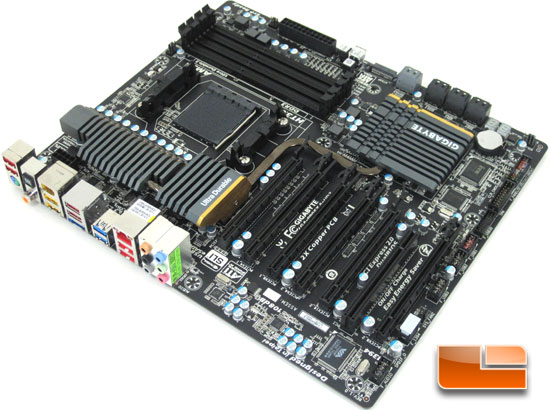GIGABYTE GA-990FXA-UD7 Motherboard Review
Final Thoughts and Conclusion

The GIGABYTE 990FXA-UD7 is one of the highest price AMD 990FX motherboards at Newegg.com. Coming with a street price of $209.99 with free shipping after a $20 rebate, it is one of the most expensive AMD 990FX motherboard there. The features that are packed into the GA-990FXA-UD7 do justify the higher price tag.
The performance of the GIGABYTE 990FXA-UD7 was solid overall. The ASUS Crosshair V Formula that we used in our first motherboard article with the AMD FX-8150 ‘Bulldozer’ did lead through most of the benchmarks. It’s fair to say that it wasn’t a blowout competition though. The GIGABYTE 990FXA-UD7 was able to pull ahead of the Crosshair V Formula a time or two. Regardless of which board took the top spot, it’s fair to say that the performance margins we saw today weren’t really enough that you would see a difference in day to day usage.
One area that was slightly disappointing was the SuperSpeed USB 3.0 testing. It didn’t do nearly as well as the ASUS Crosshair V Formula did. When we ran CrystalDiskMark 3.0.1 the sequential write speeds weren’t far off of the ASUS board. The Sequential Read speed is what had us concerned. The GIGABYTE 990FXA-UD7 was only able to hit a sequential read speed of 172.3MB/s while the Crosshair V Formula was able to hit 204.2MB/s. You can go back and check out the full gambit of SuperSpeed USB 3.0 benchmark results on our testing page.
One aspect of the GIGABYTE 990FXA-UD7 truly set it apart from the ASUS Crosshair V Formula. That was our experience when we overclocked the AMD FX-8150. When we pushed the FX-8150 on the ASUS Crosshair V Formula, we weren’t able to break 4.6GHz with all eight cores active. At 4.6GHz the system would boot up completely normal and seemed to be rock solid. When we tried for 4.7GHz the system wouldn’t even post, didn’t seem to matter if we pushed more voltage or any of the other tricks up our sleeves. It seemed that our FX-8150 was just limited to 4.6GHz with all eight cores. We were able to disable four of the cores and get to 4.9GHz. The GIGABYTE 990FXA-UD7 turned out to be a completely different story. We were able to bring the system to 4.6GHz, and didn’t plan on much more thinking that our chip wouldn’t do any more. Turns out it wasn’t the chip that was the issue. We were able to increase the multiplier to 24.5 and boot into Windows! We weren’t what we call completely stable, but if we were to switch over to water cooling we could pump more voltage and gain the system stability we desire.
Whenever it comes time to upgrade or replace a piece of computer equipment, regardless of cost, peace of mind is a must. In the event that a component should fail it’s nice to know that the manufacturer has your back. In the case of GIGABYTE motherboards, you are backed by a three year warranty.

Legit Bottom Line: The overall performance of the GIGABYTE 990FXA-UD7 wasn’t far off the competitor today. What really sold us on the GIGABYTE 990FXA-UD7 was the overclocking! We have previously been unable to POST past 4.6GHz on our AMD FX-8150, on the GIGABYTE 990FXA-UD7 we were able to boot into Windows 7 at 4.9GHz with all of the cores active!

Comments are closed.